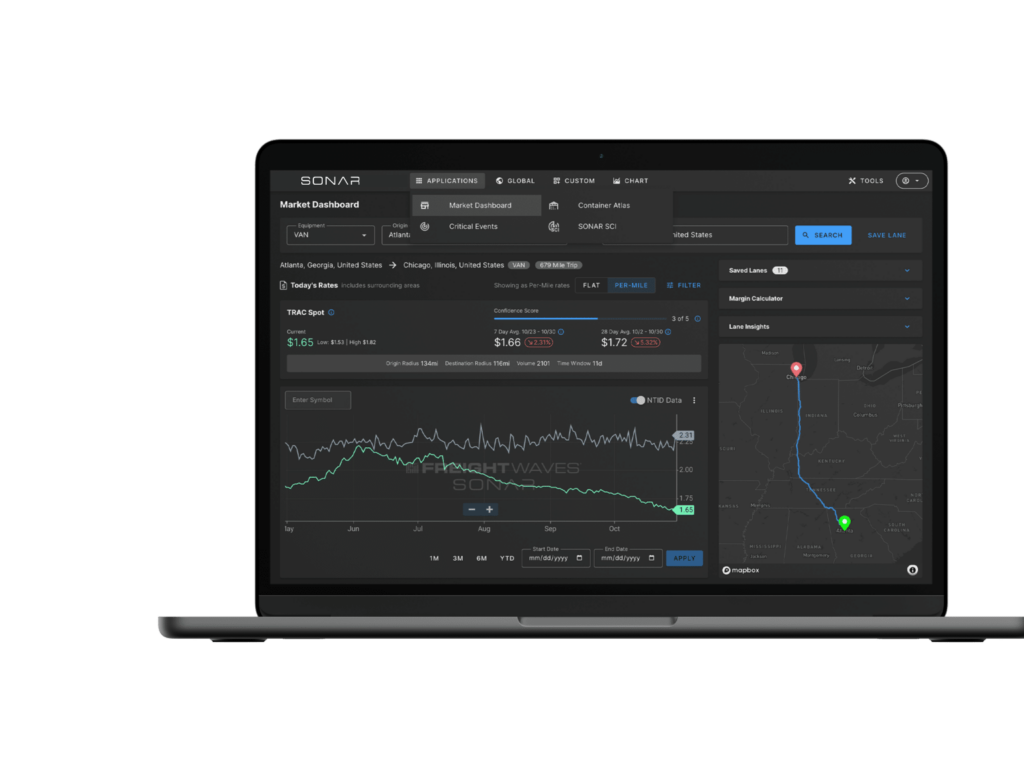Recently, a SONAR customer in the financial sector asked us why intermodal spot rates remain depressed despite the notable pickup in domestic intermodal volume.
Certainly, the divergence is striking. Here is a chart of loaded domestic containerized intermodal volume, which is a daily seven-day moving average and can be seen above, via the ORAILDOML.USA ticker.
Loaded domestic intermodal volume started to pick up just before Memorial Day and has persisted through mid-August. It’s up 6% year-over-year since the start of the third quarter and, as the SONAR chart above shows, is roughly in line with the COVID-enhanced 2H20 levels. Domestic intermodal volume is benefitting from a few factors, including record-breaking containerized import volume at the West Coast ports, additional transloading of imports from international containers into domestic containers, and a fluid rail network with associated strong service levels.
Meanwhile, here’s a chart of average intermodal spot rates, updated weekly via the INTRM.USA ticker.

The average intermodal spot rate of $1.47 across 100 lanes continues to track below the prior four years. The last time the rate was this low was early 2020, when the freight industry was still coming off of a depressed 2019 and before the COVID-related freight surge took hold of the industry.
The difference is even more striking when comparing domestic intermodal volume and domestic intermodal spot rates in the most dense and important lane – LA to Chicago.
Loaded domestic intermodal volume from LA to Chicago:

Door-to-door intermodal spot rates to move 53’ containers, including fuel and any other surcharges:

Whenever I discuss intermodal spot rates, I use the caveats that a small minority of loads move on the spot market, and it’s not clear from our data how much volume moves at those rates. I asked our supplier for that data, and they don’t know, either. Nevertheless, even if very few containers are moved at those rates, I believe there is information in the rates.
Carriers need to take care of their contractual shippers. In order to do so, carriers will raise intermodal spot rates to discourage spot volume when they are concerned with protecting capacity for their contractual customers. At times, intermodal spot rates will spike high enough to suggest that carriers are taking themselves out of a market entirely. That hasn’t happened lately, likely due to the availability of capacity. On its last few earnings calls, J.B. Hunt — the largest domestic intermodal company — reiterated that it has the resources in place (namely, 53’ containers) to handle at least 20% more intermodal volume than it is currently moving. The past two intermodal contract bid seasons have been highly competitive and resulted in contract rate declines.
The middle part of the chart below, which shows intermodal spot rates from LA to Dallas, is what intermodal spot rates look like when capacity is tight. The rates include fuel and any peak season surcharges, which appeared to have an impact in late 2020 and mid-to-late 2021.

This is all to say that I recommend intermodal shippers keep an eye on intermodal spot rates, even if they are never going to move an intermodal load in the spot market. If they move higher, it means carriers are starting to get concerned with securing enough capacity for shippers — and that’s when shippers should be concerned, too. Right now, they don’t need to be.
To learn more about how SONAR’s volume and rate data can help you understand the freight market and plan for what lies ahead, visit gosonar.com or request a demo.











